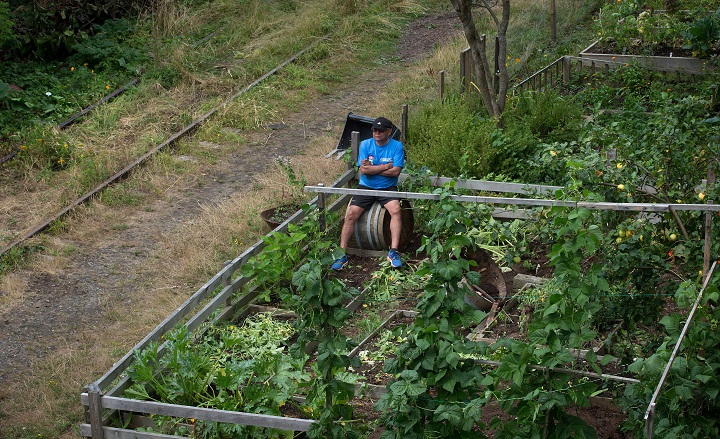MONTREAL — When U.S. President Woodrow Wilson declared that planting a garden would win the war during the First World War, Victory Gardens became both part of the economic and psychological landscape of North America in ways that would be considered revolutionary today.

Gardening is an intensely personal act.
In both Canada and the United States, the government asked citizens to grow their own food in order to contribute to a greater war effort — one which pitted good against evil and, ultimately, required the simple act of kitchen gardening as a minimum go-to standard of support for these efforts.
This call to action had a huge impact: between 1917 and 1919, an estimated five million victory gardens produced approximately US $1.2 billion worth of produce in North America.
During the Second World War, homegrown gardens produced an estimated 40 per cent of the vegetable produce in the USA. In Canada, there were more than 220,000 gardens, producing approximately 250 kg of food each year. Similar campaigns in Australia and Britain were similarly successful during both wars.
Food was on the prime-time menu of national and transnational concerted efforts in the face of the global threat of war in the 20th century.
In short, food was on the prime-time menu of national and transnational concerted efforts in the face of the global threat of war in the 20th century.
Not just because food contributed economically to the cause, but because politicians recognized that victory gardens were an important morale-boosting act that could bring the nation (and the Allies during the Second World War) together in ways that no propaganda campaign could ever do.
Why?
Gardening is an intensely personal act.
Yet in these instances it was connected to clear political and social implications that both encouraged everyday citizens to do their part that, together, had profound collective consequences for the war effort. Doing so managed to connect the personal sphere and troubles of the war home to the social and political goals of the national and international cause.
Why is this important?

Get daily National news
Because today, we face a similar task of epic proportions: climate change.
And gardening might be one the best and brightest ways that we can both individually and collectively face this challenge, particularly in developed countries.
One of the most effective ways to combat climate change is the simple act of planting a garden.
I say developed because I have lived for most of my life in the United States and Canada, where a regular supermarket trip yields produce and product from enough distant places as to make the world traveller dizzy in the recounting.
More to the point, these travels are, given the amount of greenhouse gases and energy use to produce and transport them, unsustainable in a carbon intensive world.
READ MORE: People’s Climate March set to inspire change in Montreal
And the promise or possibility is all the more significant, given what the 2013 emissions reports and the latest IPCC estimates indicate in terms of the immediacy and severity of the threat.
This week, in fact, the People’s Climate March and UN Summit are an important acknowledgment that climate change is not just some future word worth contemplating and debating. In fact, it’s here, and it’s more severe than expected.
So, what’s the average person to do?
Most of us don’t really know, because the options and connections are so wildly disconnected from everyday experience. If we are to follow recent statements and calls for collective action in the People’s Climate March by its lead activists, it seems as though we are to place pressure on governments to the exclusion of individual action.
Plant a garden.
Bill McKibben of 350.org goes so far as to juxtapose individual action as “changing lightbulbs” against the necessary collective action of pressuring governments.

Yet while it is important to pressure governments and corporations to act, it is also important to recognize that everyday actions contribute to a stronger sense of such collective efforts.
More importantly, everyday actions are more likely to bring about long-standing social change if and when the participants in mass protest can connect their individual lives and experiences within a community to proactive efforts for social change.
One of the most effective ways to involve all of us in the effort to combat climate change (in addition to demanding governmental and international action on reducing greenhouse gas emissions) is the simple act of planting a garden.
Doing so during two wars drew individuals on the home front who did not work or fight on the front lines into the collective challenge. We need a similar call to action for climate change.
If every one of us pledged to do so in the next year and managed to build some food sovereignty and security in the process, each household, community, country, and the earth would benefit.
Interestingly, doing so may also have spillover effects for the food industry that could rewire our collective addiction to cheap, industrialized and processed food products.
Of course, food industry advocates have long recognized this: when Eleanor Roosevelt planted a victory garden on the White House property during the Second World War, resistance came in the form of questions and criticism from an already burgeoning corporate food industry.
Let’s aim for 40 per cent homegrown produce.
It took until Michelle Obama’s tenure at the White House for a vegetable garden to be planted again, but she did so in the name of childhood health standards.
Let’s broaden our lens and go back to the more radical implications of her garden, aim for 40 per cent homegrown produce, and together significantly challenge the political and social landscape to reduce carbon emissions through the simple act of gardening.
On that, I think we could all take part and (hopefully) start to declare some victories in the larger climate change fight.
Anna-Liisa Aunio is a professor in the Department of Sociology at Dawson College in Montreal.





Comments